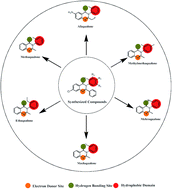Anti-convulsant potential of quinazolinones†
Abstract
A series of novel quinazoline derivatives were synthesized, virtually screened through different filters and evaluated for their anticonvulsant activity against electrically and chemically induced seizures, compared with that of the standard drugs methaqualone and sodium valproate. Compound 48, 3-(2-aminophenyl)-7-chloro-2-phenylquinazolin-4(3H)-one, was found to be the most potent compound of the series accompanied by relatively low neurotoxicity and low toxicity in the median lethal dose test as compared with the reference drugs. The obtained results showed that compounds 12, 48, 49 and 50 could be useful templates for future design, optimization, and investigation to construct more active analogs.


 Please wait while we load your content...
Please wait while we load your content...